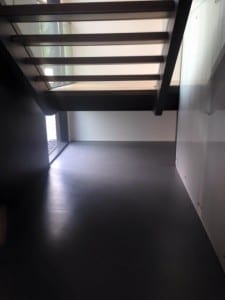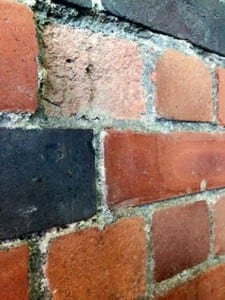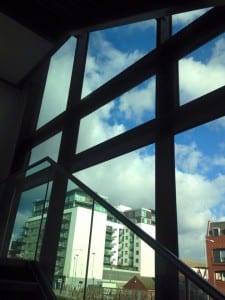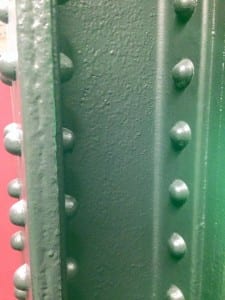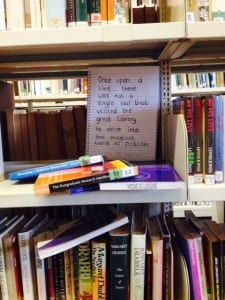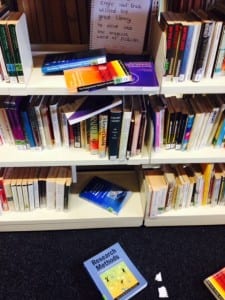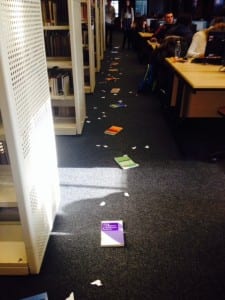After thinking of a new idea, as looking at a food library wasn’t very practical idea, we came up with the title of 101 Uses for a Library Trolley as our site has a space under the stairs, with trolleys just sitting there not being used. We then thought we could use these trolleys around the library as our performance. So by looking at the different trolley designs we started to think of different ways in which a trolley could be utilised, apart from the norm.
These are our 101 things to do with a trolley:
| Planking | Jake |
| Sleeping | Jake |
| Food Trolley | Paul |
| Chair | Paul |
| Dining Experience | Jake |
| Meditation | Sam |
| Conversations via the trolley | Jake |
| Wardrobe | Sam |
| Mime | Jake |
| Reading while riding | Sarah |
| Follow someone and use the trolley as a disguise. | Paul |
| To carry books | Sam |
| Walk around like the grim reaper | Paul |
| To not push the trolley but get it around the floor in a way | Paul |
| Jousting | Paul |
| Make a musical instrument | Jake |
| Make Facebook on the go | Sam |
| Train trolley | Paul |
| Bag trolley | Sarah |
| Advice trolley | Sam |
| Music trolley | Jake |
| Doll house trolley | Sam |
| Inspiration trolley | Sam |
| Pick up trolley and carry it. | Jake |
| Check how you look trolley | Sam |
| Car trolley | Paul |
| Take it for a walk | Sam |
| Self-moving trolley | Paul |
| Trolley race inside | Jake |
| Tolley conga | Paul |
| Trolley taxi | Jake |
| Replace the books with props | Sarah |
| Replace books with clothes | Sarah |
| Make the trolley a piece of art | Sarah |
| Paint while riding a trolley | Sarah |
| Have wrapped with a single piece of paper telling a story. | Sarah |
| Take trolley up and down the stairs | Jake |
| Fill lift with trolleys | Sarah |
| Stack the trolleys | Jake |
| Place the trolleys out side | Sarah |
| Wrap up the trolley with someone in it like a presant | Sarah |
| Wrap it up with newspaper | Sarah |
| Just walk around with them | Sarah |
| Secret mail | Sarah |
| Dancing | Paul |
| Waiting staff trolley | Sam |
| Construction sight trolley | Sarah |
| Curling | Paul |
| Bowling | Paul |
| Use it as an canoe | Paul |
| Create a rowing team | Paul |
| Use as a sun bed | Sam |
| Building a fort | Sam |
| Pac man | Jake |
| Composing a poem as riding a trolley | Sam |
| Writing a book while riding a trolley and explaining your ride | Jake |
| Tetris with books | Sam |
| Homemade theatre system | Paul |
| Dodgems | Paul |
| Taking selfies with the trolley | Sam |
| Play football | Jake |
| Pushing it upside down | Jake |
| Obstacle course | Jake |
| Hiding with it | Sam |
| Thumb wrestling arena | Paul |
| Nerf gun shield | Jake |
| Card game centre | Paul |
| Magic station | Paul |
| William Shakeshelf | Sam |
| Aeroplane trolley | Paul |
| Trolley bin | Jake |
| Collect objects around the library to make art in the trolley | Sarah |
| Barricade with trolleys | Jake |
| Trolley wash | Sarah |
| Re-create classic film scenes with the trolley as your set | Sam |
| Tea trolley | Paul |
| Yoga trolley | Sarah |
| Wedding of the trolleys. | Sam |
| Brake down trolley | Jake |
| Cuddly toy zoo trolley | Sam |
| First aid trolley | Sam |
| Replace the books with food | Sarah |
| Put a large box over the trolley | Sarah |
| Movie quote | Sam |
| University facts | Sam |
| Great literature trolley | Sarah |
| Tardis Trolley | Sam |
| Surfing | Paul |
| Safari | Paul |
| Steps | Paul |
| Maze | Jake |
| Shoes Shelf | Sam |
| Books out play dough | Sarah |
| Trolley race outside. | Jake |
| Bank | Jake |
| Rehearsing a play | Jake |
| BFF TROLLEY FOR LIFE | Sarah |
| Fish – Aquarium | Sarah |
| Comments about the library | Sarah |
| Stationary on the go | Paul |
| Wrapping trolley in toilet paper | Sarah |
As you can see we have also split up the list equally so that we all have our own 25 that we look after. The named person will be in charge of getting any equipment the trolley may need or anything that needs to be made. This makes it easier for us to handle the work load for our performance.
Samantha Foster
